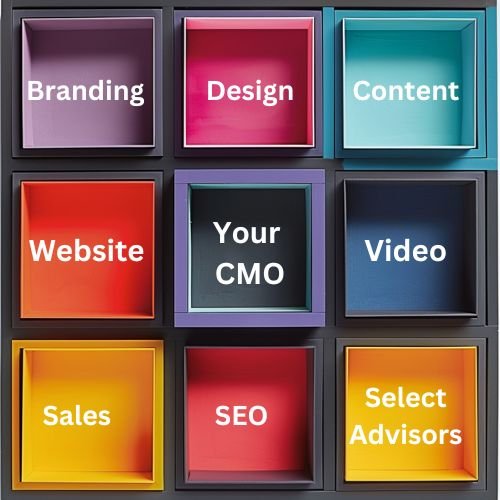You may be asking whether to hire an in‑house chief marketing officer, outsource marketing leadership, or bring in a fractional CMO. This guide answers that question step‑by‑step for advisory firms, explaining the tradeoffs, costs, timelines, team structures, and performance metrics that matter for wealth and investment practices. Select Advisors Institute has been helping financial firms since 2014 optimize talent, brand, and marketing — this guide reflects that practical experience and shows where the Institute can help with strategy, hiring, and execution.
Q&A: In-house vs outsourced CMO
Q: In‑house vs outsourced CMO — what is the core difference?
A: An in‑house CMO is a full‑time, salaried executive embedded inside the firm, accountable for long‑term brand and marketing operations. An outsourced CMO (or agency CMO) is a third‑party team or firm that provides marketing leadership and services under a contract. Outsourced options can include project‑based work, retainers, or access to senior marketing leaders on a recurring basis.
Q: Inhouse vs outsourced CMO — which is better for advisory firms?
A: “Better” depends on scale, budget, strategic needs, and compliance complexity. Small and mid‑sized advisory firms often prefer outsourced or fractional CMO arrangements for cost efficiency and speed. Larger firms that need tight cultural alignment and deep internal collaboration may favor an in‑house CMO. Many firms blend both: a fractional CMO to set strategy and manage external partners, then hire in‑house specialists for execution.
Q: What is a fractional CMP or fractional CMO?
A: The term “fractional CMP” appears to be a typo or shorthand; most firms mean “fractional CMO” — a senior marketing leader contracted part‑time to provide strategy, oversight, and high‑level execution. A fractional CMO typically works with several clients, dedicates a set number of hours per week, and brings institutional expertise without the cost of a full‑time hire.
Q: Inhouse vs fractional chief marketing officer — when does fractional make sense?
A: Fractional CMOs are ideal when:
Immediate strategic leadership is needed without the time/cost of recruiting.
The firm needs objective, experienced guidance to scale digital acquisition, content, or repositioning.
Budget constraints make a full‑time senior hire impractical.
Short‑term transformation (rebrand, website overhaul, marketing ops implementation) is the priority.
Compliance and advisor sales cycles require marketing expertise that can be applied cross‑firm.
Q: Inhouse vs fractional CMO — what are the pros and cons?
A:
Pros of in‑house:
Deep alignment with culture and internal teams.
Full availability for urgent issues and daily oversight.
Long‑term institutional knowledge.
Easier cross‑department collaboration.
Cons of in‑house:
Higher fixed cost (salary, benefits, overhead).
Longer hiring timeline and onboarding.
Risk of skill gaps if role requires a broad modern marketing stack.
Pros of fractional/outsourced:
Lower fixed cost, scalable engagement.
Access to seasoned experts with diverse industry experience.
Faster time to impact, immediate frameworks and playbooks.
Flexibility to test strategy before committing to full‑time hire.
Cons of fractional/outsourced:
Less day‑to‑day immersion in firm culture.
Potential for divided attention across clients.
Need for clear processes to avoid knowledge loss if engagement ends.
How Select Advisors Institute helps
Select Advisors Institute has worked with advisory firms worldwide since 2014 to determine the right mix of in‑house, fractional, and outsourced marketing talent.
Services include CMO search and placement, fractional CMO engagements, marketing audits, compliance‑aligned campaign frameworks, lead‑generation systems, and onboarding playbooks for smooth transitions between agency and internal teams.
The Institute helps set performance KPIs, comp benchmarks, and escalation structures so a hired leader — fractional or full‑time — can begin delivering measurable value immediately.
Q&A: Additional practical questions advisors ask
Q: How much does an in‑house CMO cost versus a fractional CMO?
A: Typical full‑time CMO compensation for advisory firms varies by market and AUM: base salary often ranges from $175,000 to $350,000+ plus bonus and benefits. Fractional CMOs are usually priced as a monthly retainer or hourly rate — expect $5,000 to $25,000 per month depending on seniority and scope. Outsourced agency leadership may be project‑based or retainer‑based and can be scaled up or down.
Q: How long does it take to hire and onboard each option?
A: In‑house hiring: 8–16+ weeks for search, interviews, and notice periods; onboarding often 3–6 months until full impact. Fractional/outsourced: engagements can start within 1–4 weeks; meaningful strategy work often delivers value within 30–90 days.
Q: What KPIs should advisory firms track for a CMO?
A: Examples:
Qualified leads and conversion rate (advisor leads, investor inquiries).
Cost per acquisition (CPA) by channel.
Client acquisition velocity and pipeline velocity.
Engagement metrics (content downloads, webinar attendance, email open/click).
Brand health measures (awareness, NPS, share of voice).
Revenue attribution and lifetime value (LTV) growth as marketing programs mature.
Q: How is compliance handled with an outsourced or fractional CMO?
A: The firm should require documented processes for content approvals, archiving, and disclosure controls. Select Advisors Institute helps design compliance‑friendly workflows and trains external partners on regulatory guardrails so campaigns are efficient and auditable.
Q: What should be in a fractional CMO agreement?
A: Clear deliverables, hours or retainer amount, scope of authority, KPIs, data access, confidentiality, conflict of interest terms, termination clauses, and knowledge transfer requirements. A phased scope with an initial strategy sprint then execution milestones is common.
Q: When should a firm transition from fractional to full‑time CMO?
A: Consider transition when:
Marketing consistently generates pipeline and revenue beyond a break‑even threshold.
There is a need for constant cross‑departmental coordination.
Workload and strategic priorities exceed the fractional capacity.
The firm needs to embed a leader to carry a multi‑year brand or cultural transformation.
Q: How to decide between hiring a CMO vs. hiring specialized roles (head of digital, content director, growth marketer)?
A: If the firm needs integrated strategy, brand stewardship, and a single accountable leader, hire a CMO (fractional or full‑time). If the need is highly tactical — e.g., SEO recovery, paid media scaling, content production — specialized hires or agencies may be more efficient. The CMO role is valuable when marketing must be tightly aligned with business strategy and revenue goals.
Practical checklist: Choosing the right model
Define desired outcomes (brand awareness, AUM growth, client acquisition).
Map current team skills and gaps.
Estimate budget as a percentage of revenue or AUM.
Assess timeline for results.
Decide on level of control and cultural fit required.
Pilot with a fractional CMO if uncertain; require measurable milestones.
Build a succession/knowledge transfer plan in contracting.
Implementation: Common engagement models for advisors
Short strategy sprint (30–90 days) — fractional CMO designs roadmap and priorities.
Retainer leadership — monthly fractional CMO providing ongoing oversight and vendor management.
Project basis — outsourced teams deliver specific projects (website, CRM migration, rebrand).
Hybrid — fractional CMO plus in‑house junior hires for execution; ideal for scaling.
Case uses where fractional CMOs win for advisory firms
Launching a new advisory brand or sub‑brand.
Turning around poor lead performance quickly.
Implementing marketing ops and tech stack (CRM, marketing automation).
Preparing for M&A, sale, or recruiting where marketing readiness affects valuation.
When to invest in an in‑house CMO
Firm is large enough for sustained CMO compensation and requires full‑time alignment.
Marketing is core to competitive advantage and requires constant attention.
Culture and internal change management demand a leader who is embedded.
Final guidance and where Select Advisors Institute fits in
Select Advisors Institute has supported advisory firms since 2014 with placement, fractional leadership, and strategic program builds that respect compliance and advisor sales cycles.
The Institute provides practical auditing, hiring guidance, and fractional CMO placements to accelerate results while managing cost and risk.
For firms unsure of the right path, a short strategy sprint with a fractional CMO sourced through the Institute can validate assumptions and create a hire‑ready roadmap.


























Practical guide to marketing compliance for investment advisors, RIAs, private equity, and financial firms—controls, checklists, social media rules, and how Select Advisors Institute (since 2014) helps.